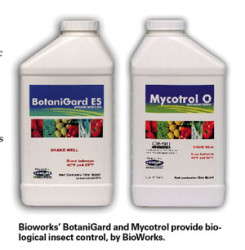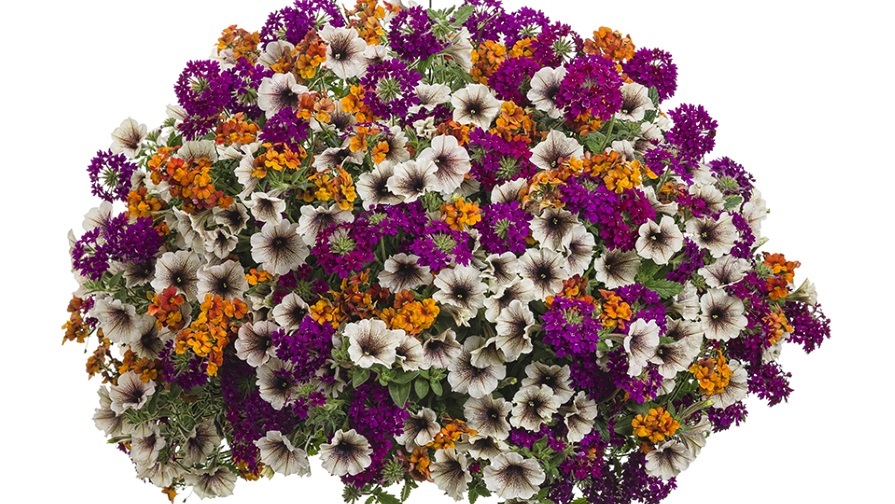Healthy And Earth Friendly

The plants in your greenhouse leak carbohydrates through their roots, attracting pathogens and disease. Imagine a first line of defense at the root, organisms that coil around the roots without harming them, keeping bad organisms away. That’s exactly how one class of sustainable disease control works.
Retailers and end consumers are driving demand for organic and sustainable products. In response, there are many new products on the market in fertilizers and pest and disease control that produce healthy plants and greenhouse workers, as well as a healthy planet.
Pest And Disease Control
Sustainable and even organic products and the way they are marketed have changed a lot over the last decade.
“The problem has been there have been so many bad actors that have come out with products that make grandiose claims of what they can do–grow bigger plants, bigger and better roots,” says John Francis, director of marketing and technical services at BioWorks, supplier of RootShield, PlantShield, BotaniGard, TriCon and NemaShield controls. “Biologicals got the reputation of being snakeoils. They were overpromised and underdelivered.”
Today, biologicals producers are trying to get the right ideas into growers heads about their products and how they work through trials and showing growers the benefits of biologicals.
First off, growers need to apply biologicals before there is a pest problem. “Biologicals are preventative, not curative,” Francis says. “I think in the past some growers have tried them when they had a problem, and that convinced them the products were no good.” If disease pressures get too high, it could be time to apply a chemical to control it.
Many growers using beneficials can go years without doing more than spot sprays of oil or soap now and again, according to Carol Glenister, founder and president of IPM Laboratories. “In the case where a pest does break out, the pests are susceptible to the chemicals because they meet them so rarely,” she says. IPM Laboratories’ products include biological solutions for aphids, fungus gnats, mealybugs, spider mites, thrips and whiteflies. These kinds of controls allow zero re-entry intervals and workers don’t worry about handling chemicals. Many growers report improvements in plant quality.
“Foliage has no chemical residue and no chemical burn,” Glenister says. “Many growers recount how cut flowers jump into the next higher grade because low-level damage caused by pesticides is no longer present.”
While a better plant can be a side effect of a biological program, Francis tells growers there is no silver bullet. While many biological products can produce bigger, stronger plants, they are only meant to control pests and diseases.
“If a grower is really excellent, if he has all his trace elements, macronutrients, growth regulators and everything down pat and the only thing plaguing him is disease, he may not see bigger roots or a bigger plant,” Francis explains. “A grower with subpar production may actually see more response.”
One of BioWorks’ biggest challenges is getting growers to stop applying chemical pest control when using biologicals, Francis says. In many cases, it doesn’t hurt the biologicals, but it is a waste of money.
Glenister says it is a good rule of thumb to review pesticide treatments over the last three months before purchasing natural enemies.
“If there is still some pesticide residual, you may have to wait another crop before starting releases,” she says.
Francis says that growers want to know two things before buying a product: does it work and how much does it cost. He says that while initial applications may cost more, follow up applications are less expensive. The fact that these products are healthy for the environment is just a bonus, in some cases.
Plant Nutrition
Plant fertilizer has come a long way from horse manure, with origins of chicken, fish, worm castings and even other plants. Daniels Professional Plant Food is derived from oilseed extract and interest in the product has grown dramatically in the last five years, says Janet Curry of Daniels.
“Soybeans contain over 130,000 organic compounds, NPK, all of the trace elements, calcium, magnesium, sulfur,” she says. “Everything nature put into a seed to reproduce the species.” Growers are using the product from propagation to finish for herbs, vegetables, perennials, poinsettias, mums and annuals. The fertilizer is also a source of nutrition for beneficial microbes.
Because Daniels Plant Food isn’t made from fertilizer salts, EC in plants will be about 40 percent less compared to water-soluble fertilizers. Lower salt levels mean stronger stems on crops with longer growing periods, like mums and poinsettias. Growers have also reported compact plants and the reduced use of PGRs when using Daniels.
How healthy can plants be if soil isn’t healthy? The goals of products produced by Organica Biotech is to improve soil biology and address the nutritional requirements of plants. The company’s horticultural products feed soil by introducing beneficial microbial species that allow natural growing processes to take place.
“In nature, plants have developed a symbiotic relationship with beneficial microorganisms,” says Robert Knaub of Organica Biotech. “If you remove the beneficial microbes through the sterilization process, you upset the natural balance and problems ensue. Many greenhouse growers are experiencing problems that can only be addressed by improving soil biology.”
Knaub also reports that once initial costs are out of the way, organic and sustainable programs’ costs go down.
“At some point down the road, it is actually cheaper to use sustainable products than traditional products,” he says. “Obviously, it depends on how out of whack and deficient your soil is to begin with. Over the years, we have observed a rather quick turnaround in greenhouse and nursery settings.”








